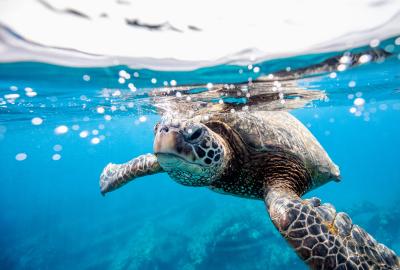Harmful "forever chemicals" are in drinking water: What you need to know
EPA regulations aim to reduce the worst of these chemicals in tap water, but there are ways to protect yourself right now.
Update April 10, 2024: Today, the U.S. EPA issued the first national drinking water standards for several per-and polyfluoroalkyl substances (PFAS), also known as “forever chemicals.” The final rule gives regulated public water systems three years to monitor for the chemicals and requires them to implement solutions to reduce PFAS if levels are above the new standards.
Since the 1940s, a class of chemicals called PFAS has been used in everything from food wrappers to waterproof jackets.

They are useful because they repel grease, water and oil, but they also have a pretty big downside: They're incredibly bad for your health. Some common forms harm the immune system, the reproductive system and increase the risk of certain cancers. A recent study found that women with higher levels of PFAS in their blood had a 40% lower chance of becoming pregnant.
Because they don't break down easily, PFAS have accumulated in the environment — earning the nickname “forever chemicals” — and contaminating our soil and water.
But recently, the U.S. Environmental Protection Agency moved to regulate the worst of these chemicals in drinking water to reduce the public’s exposure.
We asked Environmental Defense Fund’s chemicals expert Tom Neltner to explain what the proposed rules will do — and what you can do right now to protect yourself from PFAS in your drinking water.
What are PFAS chemicals?
PFAS stands for per- and polyfluoroalkyl substances — it’s chemical geek for something that’s loaded with fluorine atoms. They have many uses. For example, these chemicals are used to make jackets water resistant, frying pans nonstick and to protect food wrappers from grease. PFAS have also been used in firefighting foams, though that is being phased out. They are entirely man-made, and because they're used in so many things, they're all around us.
How do these chemicals end up in our water?

When PFAS are made, or used, some gets released into sewers or into the air, and because they don’t degrade easily, these chemicals eventually make their way into our water.
What are the adverse health effects of PFAS?
They can build up in your body to levels where we can see health harms. The harm that’s driving the latest EPA action to regulate these chemicals in drinking water is to the immune system.
For example, some PFAS chemicals undermine your immune system’s ability to fight off viruses. Not only that, they have been linked to cancer, and they affect the reproductive system.
What would the EPA’s regulation do?
The rule puts a limit on six of the worst forms of PFAS in drinking water that utilities will have to comply with. Utilities supplying water with PFAS levels over the limit will be forced to alert the public and take steps to clean up the supply, or face enforcement.
Who might resist regulating “forever chemicals” in drinking water?
The drinking water utilities are concerned about finding a way to pay for controls to remove PFAS, such as treating water with granular activated carbon. In 2022, the U.S. Congress passed the Bipartisan Infrastructure Law, which set aside $5 billion to clean up PFAS and other contaminants. But the cost will likely exceed that. So, utilities are asking “how will we pay for it?”
What really bothers me, though, is that the utilities didn’t create this problem. The source of the problem is the companies that made, and continue to make, PFAS as well as the companies using the chemicals. But the utility — and the consumer, through their water bill — is being asked to pay to clean up someone else’s mess. It's the polluters that need to pay.
Are there any home filters that capture PFAS chemicals?
Yes. An NSF 53 filter removes the most worrisome types of PFAS. NSF stands for National Sanitation Foundation. If you go to their website, you’ll find a list of filters that can do the work — just make sure it’s certified for PFAS. It won’t eliminate your exposure, but it will reduce it.
This is a particularly important option for the 23 million U.S. households who rely on well water. Wells will not be covered by the EPA’s proposed rule. It only applies to big water systems.
How can consumers discourage the use of PFAS in the first place?
Consumer demand is a powerful influence. There are safer substitutes for PFAS, but the companies using these chemicals need to put in the effort to conduct hazard assessments and consider alternatives. Hearing from customers can give them a reason to do that.
EDF works directly with a variety of businesses to introduce them to alternatives to PFAS, and, importantly, educate them on where PFAS might be lurking in their supply chains.
On the policy side, EDF and our allies also have a citizens’ petition that individuals can support before the Food and Drug Administration asking it to remove its approvals for these chemicals in food packaging.


